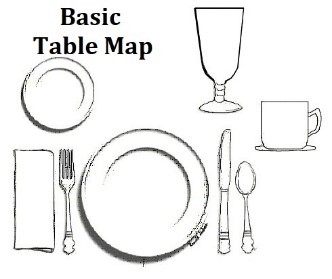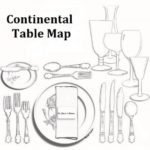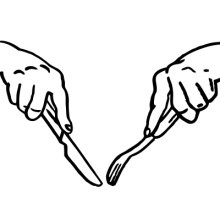
Dining the Right Way
Meal-related business and social engagements are powerful ways to gain the competitive edge and establish successful partnerships. Success requires not only a great product or service but also excellent people skills and conduct. Poor command of a dining situation and mediocre manners can hamper a seal-the-deal-at-a-meal opportunity. You are not just seen at your table, you are also observed by everyone around you.
There was a time when confusing a dinner fork with a salad fork marked an individual as “ill-bred.” This has somewhat changed. We are faced with a fast-food generation that did not receive this traditional training. Knowing the difference, however, can be important in high-level business circles and when travelling internationally.
Furthermore, the desire to experience unfamiliar cuisines has created a wide range of dining options. You do not have to visit the country; just visit the restaurant. Making the transition from casual to formal dining or from American to an ethnic cuisine is not an easy task, but it is easily learned. You must know and understand each environment and what is expected of you. It is part of developing impressive dining decorum.
A table map (e.g., place setting) is your road map to dining success. Knowing how to read a table map will guide you through place-setting confusion by assisting you in knowing which utensils are used first and which water goblet or wineglass is yours. If you pick up the wrong utensil, glass, or napkin, it can throw off the flow of the entire table and create confusion for other diners. Knowing the table layout will prevent these awkward moments from occurring. Additionally, there is a difference between ordering off the menu and attending a prix fixe meal or banquet, where the courses have been pre-planned.
 When ordering from a menu, your basic place setting will consist of minimal utensils, a napkin, a water glass, and possibly a coffee cup. In a formal setting that includes additional utensils, the utensils that are not going to be needed after an order is placed will be removed.
When ordering from a menu, your basic place setting will consist of minimal utensils, a napkin, a water glass, and possibly a coffee cup. In a formal setting that includes additional utensils, the utensils that are not going to be needed after an order is placed will be removed.
 When a menu has been preplanned (e.g., prix fixe or banquet) all utensils and glassware needed for every course are present on the table. The more courses planned, the more utensils, plates, and glassware. If a multi-course Continental-style meal is planned with accompanying wine pairings, this can be mindboggling for the novice diner. This is important to know as you navigate a place setting that is crowded, confusing, or overwhelming. (Note that the illustration shows salad after entrée.)
When a menu has been preplanned (e.g., prix fixe or banquet) all utensils and glassware needed for every course are present on the table. The more courses planned, the more utensils, plates, and glassware. If a multi-course Continental-style meal is planned with accompanying wine pairings, this can be mindboggling for the novice diner. This is important to know as you navigate a place setting that is crowded, confusing, or overwhelming. (Note that the illustration shows salad after entrée.)
 BMW Formula: Bread (left) Meal (center) Water (right)
BMW Formula: Bread (left) Meal (center) Water (right)
Easy! You will never pick up the wrong water or wine glass knowing that yours is the one on the right. Your utensils are used in a logical progression from the outside in on both sides of the plate. This rule is especially important when there are multiple knives, spoons and forks. (Note that the illustration shows salad before entrée.)
The following will serve as your guideline.
- Knives (salad and entrée) go to the right of the plate with the cutting edge facing toward the plate. (Steakhouses will typically place their signature steak knife above the plate or alongside the table service knife.)
- Spoons are placed to the right of the knives.
- Forks go to the left of the place setting.
- You will not always get a salad fork and a salad knife. Typically, only the salad fork is set.
- Dessert fork and/or dessert spoon and coffee spoon are present at the top of the plate or they are brought with the dessert and coffee.
- Use your utensils starting from the outside and move inward toward the plate.
 DO NOT STAB AND SAW! Your fork is not a pitchfork nor your knife a saw. Holding your knife and fork properly gives you better leverage and projects a fine diner image. When using a knife and fork, place the index finger on the spine, pointing down the handle. This will help give you better leverage and control, reducing the risk of spillage from the plate to the tablecloth. Keep your elbows in. The fork is used to steady the meat or vegetable while the knife cuts a bite-size morsel. The exception is the fish knife, which is most often used in Continental dining. It is held like a pencil and purpose is to fillet the fish off the bone.
DO NOT STAB AND SAW! Your fork is not a pitchfork nor your knife a saw. Holding your knife and fork properly gives you better leverage and projects a fine diner image. When using a knife and fork, place the index finger on the spine, pointing down the handle. This will help give you better leverage and control, reducing the risk of spillage from the plate to the tablecloth. Keep your elbows in. The fork is used to steady the meat or vegetable while the knife cuts a bite-size morsel. The exception is the fish knife, which is most often used in Continental dining. It is held like a pencil and purpose is to fillet the fish off the bone.
There are five styles of service and eating, which will lend unique utensils, alter the order of service, and command different ways to hold the fork and knife.
1. American–Style: When cutting meat, the knife is in the right hand and the fork is in the left hand. After cutting, the knife is placed at the top of the plate (blade facing the center of the plate) and the fork is switched to the right hand (tines up). Once the knife is placed at the top of the plate and eating proceeds with the right hand, the left hand remains on the lap or the wrists rests on the edge of the table. A small piece of bread is often used to push challenging food (e.g. peas or corn) onto the fork. However, do not mop your plate with the bread!
2. Continental/European-Style: When cutting meat, the knife is in the right hand and the fork is in the left hand. After cutting, the fork (tines down) and the knife remain in the hands (no switching). The knife is used to cut food and is used to slide (or slightly push) food onto the fork (tines up). Both hands remain in view throughout the meal (resting wrists on edge of table).
3. Continental/British-Style: Same as Continental/European-Style EXCEPT after cutting, food is slid on top of the tines (tines down) in a stacking format. It is an art form to be able to pierce meat and stack potatoes and vegetables on the back of the fork, and then proceed to eat! The knife is used as a pusher; fork tines always remain down!
4. Asian/Chopsticks: Chopsticks replace a knife and fork and vary in length and thickness and are used with one hand. Bite-size morsels are picked up from a plate. A bowl is lifted up to your mouth and chopsticks scoop the food to the mouth. A short-handled oval spoon is used for soups.
5. Middle Eastern: Eating any food with the hands instead of utensils is the norm. This style of eating only involves the right hand. (The left hand is considered unclean for eating.) Typically, the first two joints of the thumb, pointer and middle finger touch the food.
Finger food is food that is eaten directly using the thumb and index fingers and does not require utensils. (The exception would be eating at fast food eateries.) When dining in a restaurant, consider the following:
- French Fries: Use fingers if small and crisp. Large fries (steak fries) require a knife and fork.
- Bacon: If the bacon is limp, use a knife and fork. If it is crisp, it is finger food.
- Crab claws: Pick up with fingers, dip in sauce, and suck meat out (or use a cocktail fork.)
- Hors-d'oeuvres: Finger food if small. Use common sense here. Messy hors-d’oeuvres require utensils.
COMMON SENSE TIPS
1. BMW (Bread and side plates on the left; Meal or entrée center; Water and other beverage glasses on the right)
2. Use utensils from the outside in.
3. Use your fork to steady and knife to cut. Do not stab and saw! (When cutting, place the index finger on the spine of the knife and fork, pointing down the handle.)
4. If eating American-style, use your bread as a pusher. If eating Continental-style, use your knife as a pusher to deposit food onto your fork.
5. Finger foods are foods that are small (or crisp like bacon) and do not require a knife and fork.
I hope you have found these dining tips helpful. Enjoy your next dining experience with elegance and skill. Bon Appétit!
Article submitted by Gloria Petersen, Author of “The Art of Professional Connections, Dining Strategies for Building and Sustaining Business Relationships.” Email: [email protected]



